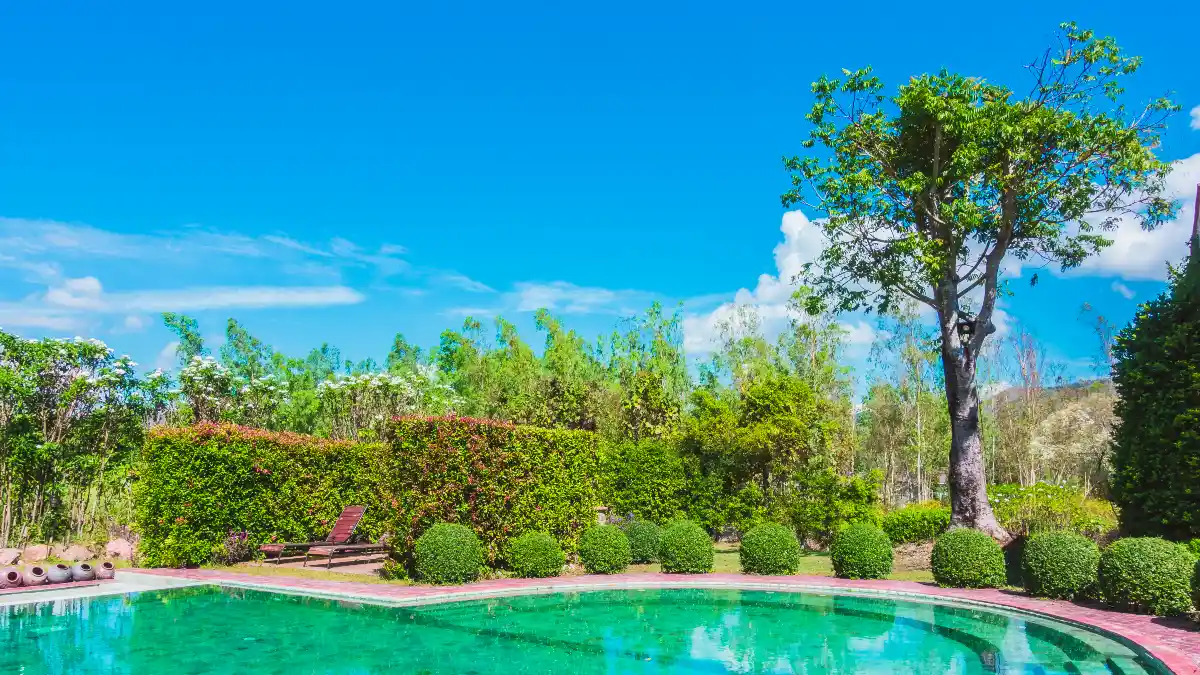You can get the tropical look without clogged filters, cracked paving, or 40-foot monsters towering over your pool. The trick is picking small palm trees for pool area use that actually stay small, keep litter low, and won’t create maintenance headaches. Too many “best palms for around pools” lists gloss over realities like true mature size, cold tolerance, and how plants respond to salt or chlorine. University of Florida palm anatomists explain that palms grow a dense, fibrous, non-invasive root system (very different from woody trees), which is why they’re generally safe near hardscape when you give them a sensible setback.
If you have a salt-chlorinated system, typical salinity runs 2,700–3,400 ppm (around 3,200 ppm is ideal). That’s still the “freshwater” range, so many plants tolerate occasional splash—but none appreciate constant soakings of salty or chlorinated water.
In this guide you’ll get 11 vetted, compact palms with verified height, spread, USDA zones, salt notes, and care tips, plus fast rules on roots, spacing, and splash management. We’ll flag spines, fruit drop, and real-world growth (not just nursery tag numbers). By the end, you’ll know which best palms for around pools fit your climate—and how to site them so your oasis stays serene. (Keywords to weave in: small palm trees for pool area; best palms for around pools; non-invasive palm roots.)
How to choose a pool-safe small palm
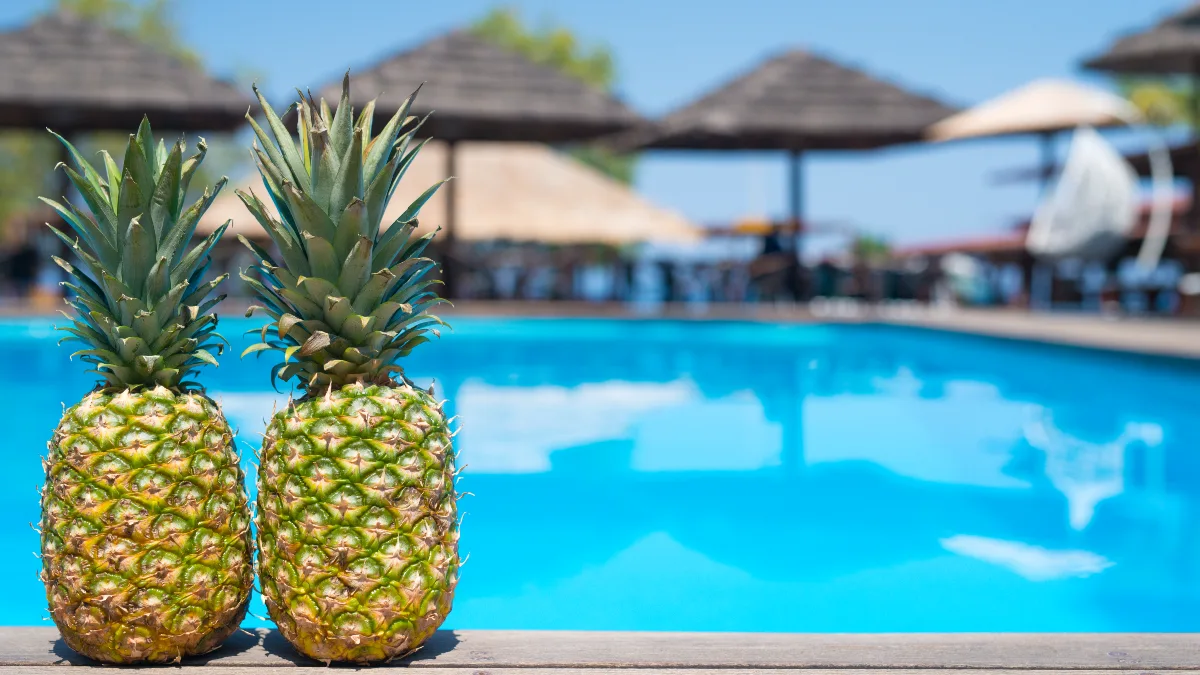
Poolside Palm Quick Selector (2025)
Actionable cues for climate, chemistry, safety and spacing—built to complement your buyer’s guide.
Match Climate First
Data informed by Missouri Botanical Garden, UF/IFAS, and NC State Extension.
Water Chemistry Reality Check
Salt-pool salinity runs ~2,700–3,400 ppm (≈2.7–3.4 g/L). That’s freshwater range — many palms tolerate occasional splash. UF/IFAS cautions no landscape plant handles a continual deluge of salt or chlorine. Rinse foliage after big pool days.
Salinity norms: Hayward (engineering guidance); plant response: UF/IFAS.
Spacing That Saves Your Hardscape
| Mature Frond Length | Suggested Setback from Waterline | Notes |
|---|---|---|
| < 2 ft | ≈ 3 ft | Good for planters and tight courts; still allow service access. |
| 2–4 ft | ≈ 4–6 ft | Typical of windmill/lady in smaller landscapes; keeps fronds off coping. |
| 4–6 ft | ≈ 6–8 ft | Use for clustering clumps (e.g., *Rhapis*) and to clear skimmer lids. |
Why: Palms have fibrous, generally non-invasive roots that spread laterally. Give a maintenance corridor and use large containers if you must plant closer.
Root behavior summarized from UF/IFAS palm physiology notes.
Safety Flags Near Seating & Steps
Spines: Pygmy date palm carries sharp 2–3″ spines on basal leaflets — set back from walkways and kid zones.
Low-litter picks: Favor self-cleaning or tidy clumps (e.g., bottle, spindle, lady) close to decks; save heavy shedders for back borders.
Microclimate: Bright, reflective decks raise heat stress. Give shade-tolerant Chamaedorea species afternoon shade.
Species traits compiled from UF/IFAS and NC State Extension fact sheets.
Three-Step Reality Check (Before You Buy)
Cross-verify mature size
Compare the nursery tag with at least one independent source (e.g., Missouri Botanical Garden). Use the smaller of cold-region sizes for tight courts.
Match zone to lows
Confirm USDA zone and your typical winter low. If you’re 7–8, shortlist windmill/needle/dwarf palmetto. Zones 10–11 unlock tropicals.
Check salt & setbacks
Salt pool ≈ 2.7–3.4 g/L: keep plants off the coping, rinse after splash events, and follow the frond-length setback table above.
Attributions (no links): Missouri Botanical Garden (size benchmarks); UF/IFAS (cold notes, physiology, maintenance); NC State Extension (species habits); Hayward (salt-system ranges).
1) Space & scale (verify mature size). Don’t trust the pot label—confirm with extension/botanical sources. For example, the Missouri Botanical Garden notes the windmill palm typically tops out at 8–10 ft in cold-winter areas (so it truly fits tight pool courts there).
2) Cold & heat (match USDA zone). Pick species proven for your lows. UF/IFAS notes windmill palm has handled about 10°F and is used from Zone 8A south; NC State lists Sabal minor (dwarf palmetto) hardy to Zone 7 with protection. If you’re in Zone 10–11, more tropical picks open up.
3) Salt & chlorine reality. Salt-pool salinity is 2.7–3.4 g/L. Keep plants off the coping, and rinse foliage after big splash events; UF/IFAS reminds us no plant tolerates a continual deluge of salt or chlorine.
4) Spines & litter. Around seating and steps, avoid spiny petioles (e.g., pygmy date palm has 2–3 in sharp basal spines). When possible, choose “self-cleaning” crown-shafted palms (old fronds drop neatly) to reduce trimming on deck edges.
5) Roots & distance. Palms have fibrous, generally non-invasive roots that radiate laterally; very large specimens can extend roots outward many feet. Leave a practical service corridor between trunk and waterline/equipment—aim for at least one frond’s length (≈3–6 ft), and use large containers if you must plant closer.
Quick examples: windmill palm’s cold notes (↑), salt-pool ppm (↑), and the salt-intolerant flag for pygmy date palm are your red-light/green-light checks before buying.
Windmill palm
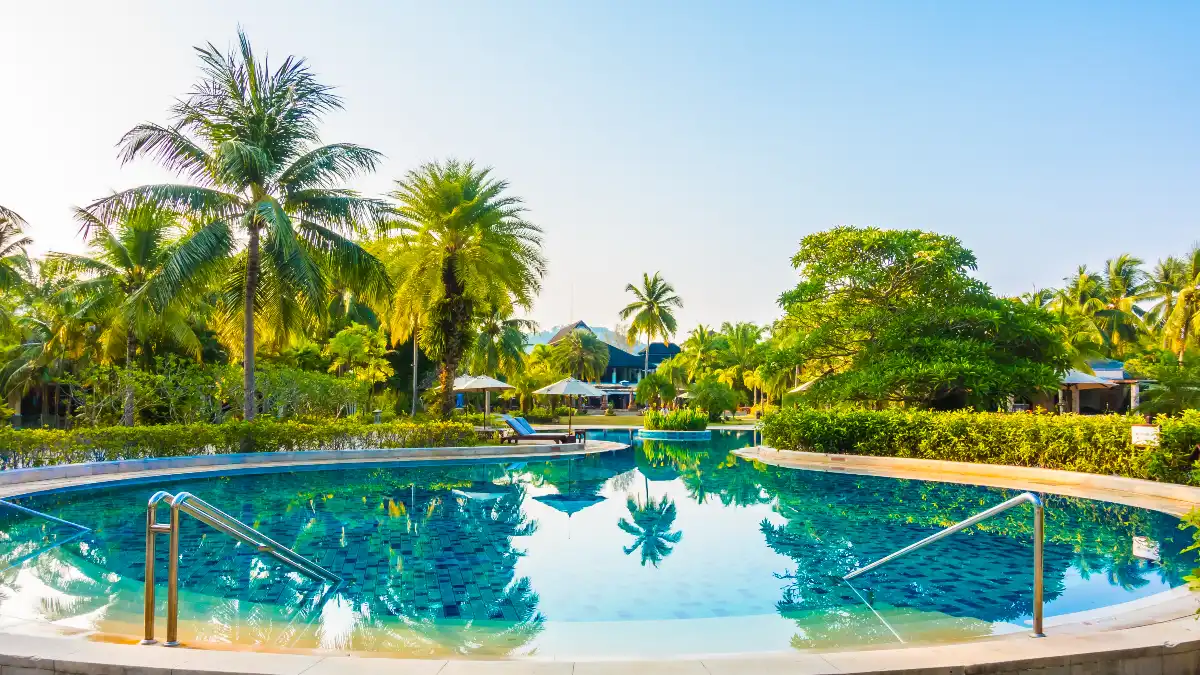
If you want a hardy, elegant windmill palm pool specimen for temperate zones, this is the go-to. Missouri Botanical Garden reports that in cold-winter regions (USDA 6–7) windmill palm typically tops out around 8–10 ft, which keeps scale right for patios and screened enclosures. In warmer spots it can grow taller, but UF/IFAS still calls it one of the most cold-hardy palms, with performance down to about 10°F and practical landscape use from Zone 8A–11.
Why it works poolside: a slow growth rate; fan leaves that read “tropical” without becoming a sail; and modest litter—UF/IFAS notes flowers and fruits aren’t a big mess, which helps keep filters clean. It also adapts to partial shade and shows moderate salt tolerance, but as with all small palm trees for pool area use, avoid constant splash and provide a rinse after heavy pool parties. Site in a roomy container or a bed with good drainage; allow a clear maintenance path between trunk and coping.
Dwarf palmetto
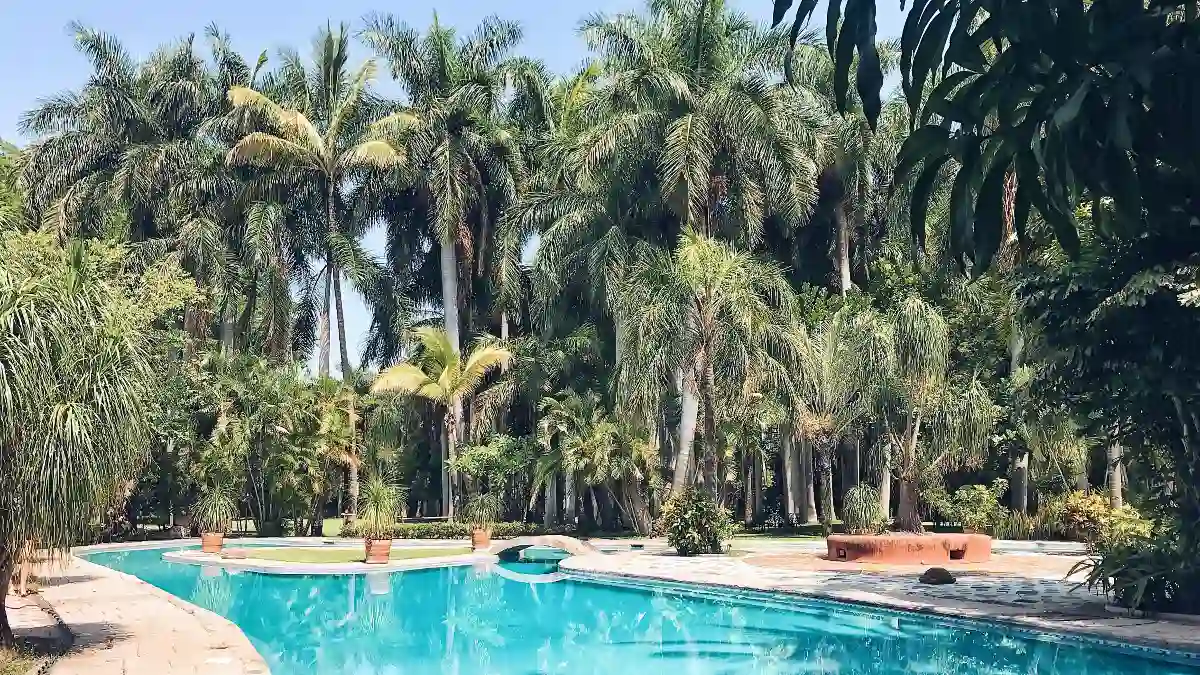
A standout for shade palms for pool zones 7–10, Sabal minor stays genuinely compact: NC State lists 2–10 ft tall with 4–6 ft spread, slow-growing, and with moderate salt tolerance—handy for the odd splash if you’re not right on the coping. Its trunk typically remains underground, giving you a tidy, fan-leaf clump that won’t loom over decks or screens.
UF/IFAS describes dwarf palmetto as an understory species of moist sites; it will even bloom while under 5 ft tall (the tall flower spadix is a good ID clue). That makes it perfect for the north side of enclosures, privacy nooks, and pockets where turf struggles. Keep soil evenly moist the first year, then it tolerates periodic dry spells. For poolside use, plant back from the waterline (or in a large 18–24″ container with drain holes) and mulch a 2–3 ft ring to keep grit out of skimmers. Keywords to weave: dwarf palmetto pool; small palm trees for pool area.
Needle palm
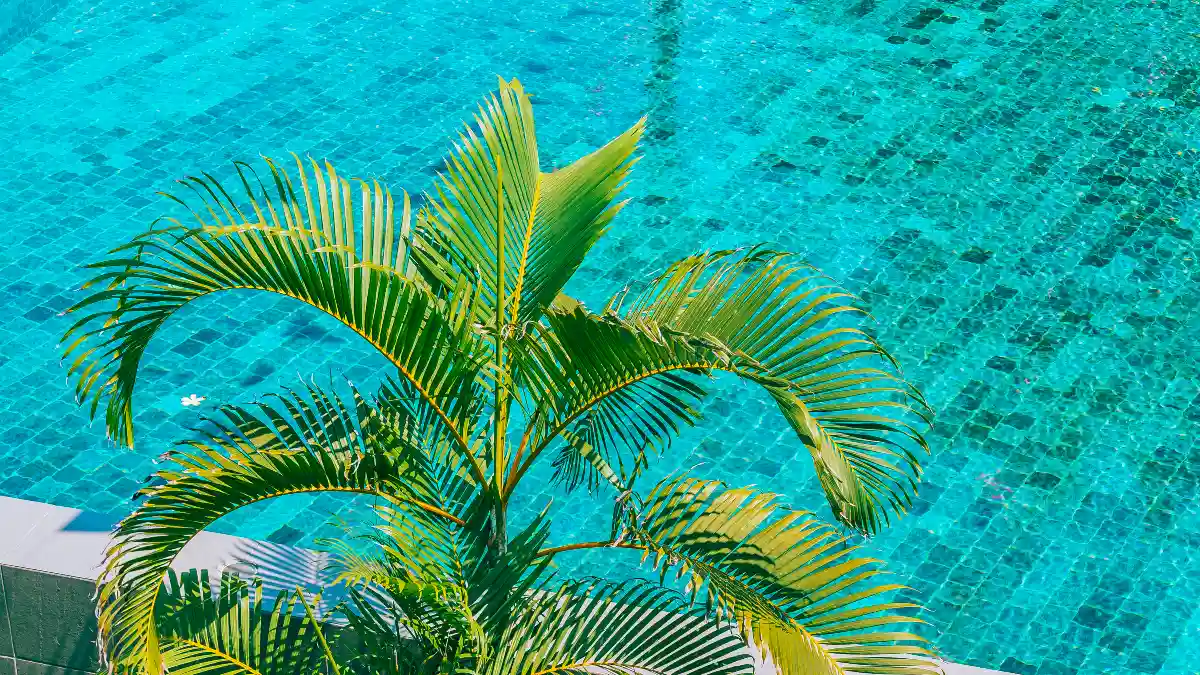
If you need a cold hardy pool palm that truly stays compact, needle palm is the safest bet. NC State’s Plant Toolbox documents a 3–6 ft mature height with a 4–8 ft spread, a slow, suckering habit, and the distinction of being the most cold-hardy landscape palm (surviving down to USDA 6b with protection). It tolerates moist to well-drained soils, even periodic wet feet, then becomes fairly drought-tough once established—useful for the microclimates around decks.
The basal “needles” (6–10″ spines) sit at the leaf bases, so set the clump back from walkways and skimmer lids. For tight courts, it also performs well in large containers, which simplifies spacing around coping and equipment. Saltwise, university tables list moderate tolerance—fine with occasional splash but not constant spray.
In short: resort look, genuine cold credentials, and a footprint that fits most small pool terraces. (Keywords: cold hardy pool palm; small palm trees for pool area.)
Lady palm
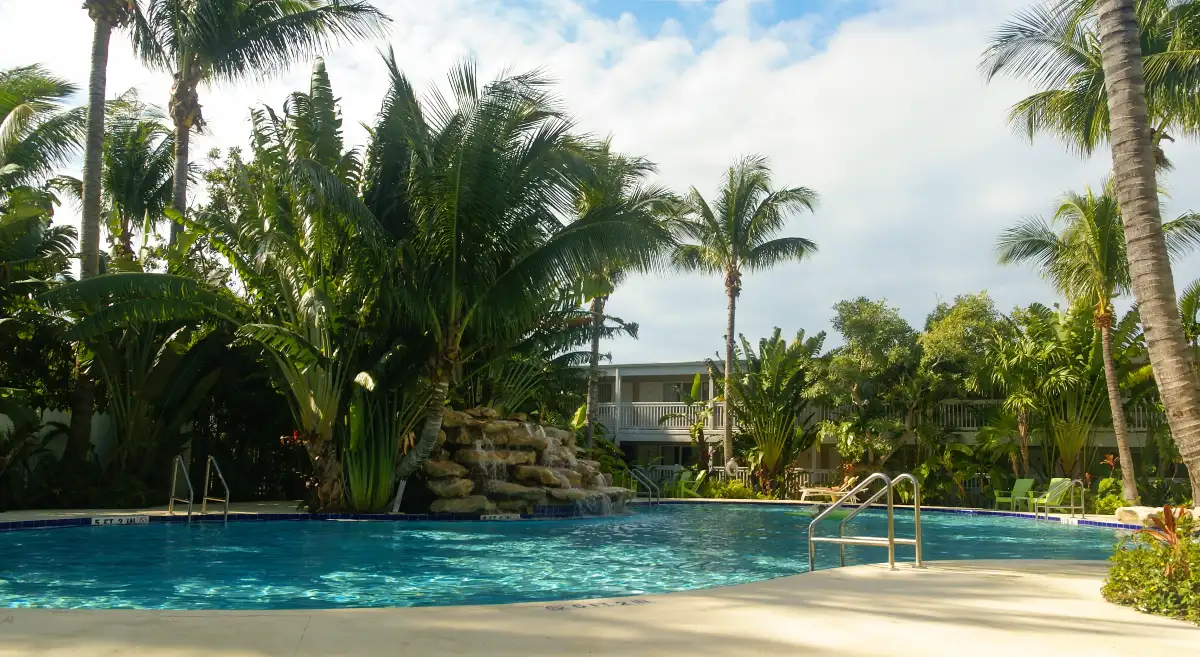
For shaded lanais and seating nooks, lady palm is a crowd-pleaser. The NC State Plant Toolbox records USDA 9–11 hardiness and an outdoor size band that legitimately reaches 8–12 ft (with 6–15 ft spread in mature clumps). It’s a clumping palm on underground rhizomes, “houseplant-easy” yet tough enough for protected outdoor courts in warm zones.
University of Florida palm tables list ~8 × 8 ft as the typical landscape habit in South Florida and mark moderate salt tolerance—translate that to “OK with the odd splash, but not right on the coping.” In practical terms, it’s low-litter compared with many feather palms, and the upright canes make a refined privacy screen near lounges and outdoor showers.
Use it where you want an evergreen texture without spines, and give a wide decorative pot if you’re staging it on decking. (Keywords: lady palm pool area; dwarf palms for poolside.)
Cat palm
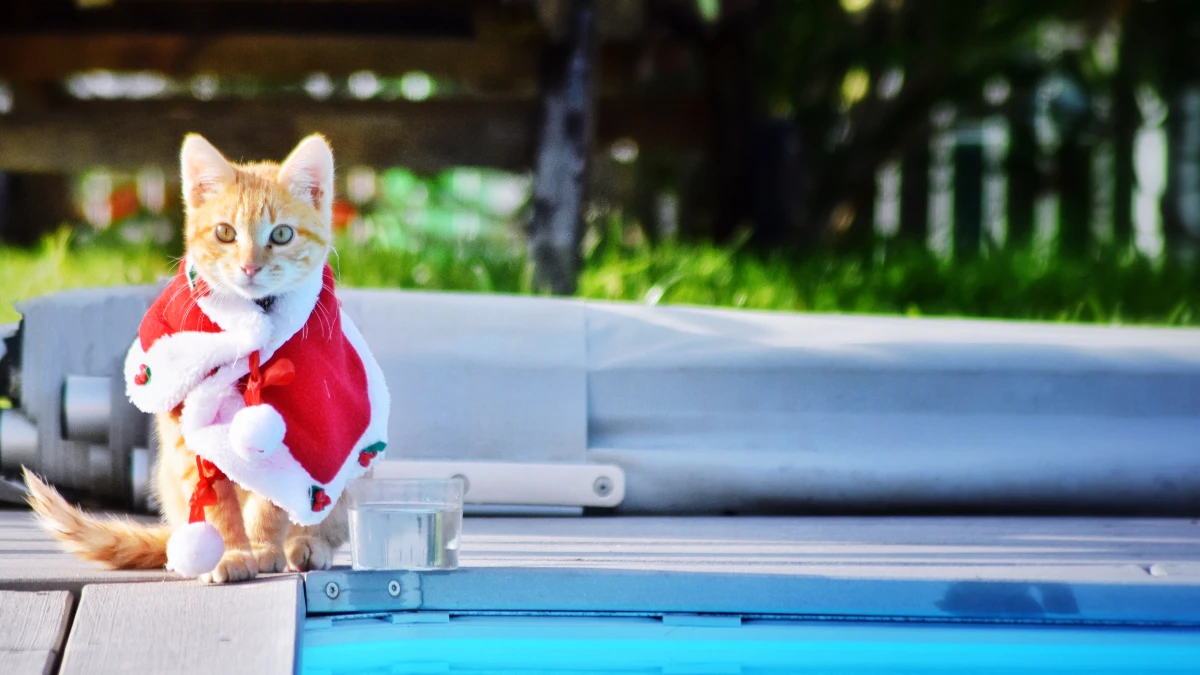
Think of the cat palm as the lush, fountain-form hedge for shaded pool edges. UF/IFAS lists a typical ~8 × 8 ft habit outdoors in South Florida and flags low salt tolerance—keep it back from direct splash or grow in a large container just off the coping line. Clemson Extension notes this species thrives when soil is kept evenly moist (not soggy), which is key in planters and wind-sheltered courts that dry unevenly.
As a trunkless, clumping palm, it reads softer than spiny date relatives and is easy to prune for a tidy base (“skirt” the lowest fronds to clear equipment paths). Plant in partial shade or bright, filtered light; in hot sun areas, plan on afternoon shade and mulch to stabilize moisture. Use it where you want a green “screen” without hard leaf bases scraping passersby. (Keywords: cat palm pool; small palm trees for pool area.)
Bamboo palm
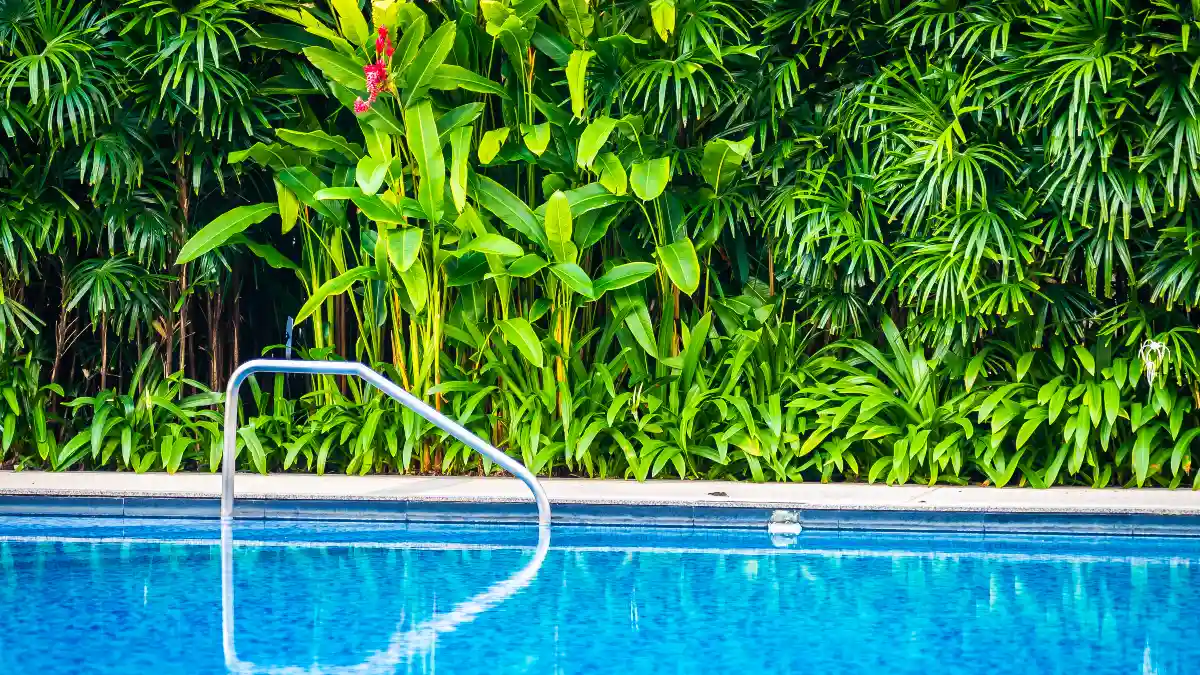
For tight side runs and narrow sightlines, bamboo palm gives you a slim, upright clump that’s easy to stage in planters. NC State profiles 3–7.5 ft tall with 3–6 ft spread in landscape use (upright, slowly widening clumps). Clemson Extension’s indoor/landscape guidance notes 8–10 ft is attainable in good conditions, which aligns with UF/IFAS’s South Florida table listing ~8 × 6 ft as typical.
It’s happiest in partial shade with a moist, well-drained mix; salt tolerance is low, so keep it off the coping and out of constant spray. In containers, rotate quarterly to keep canes plumb, and prune old fronds flush to maintain the “reed” look. Use as a modular privacy block behind chaises or along screens where a feather palm would overwhelm the space.
Parlor palm
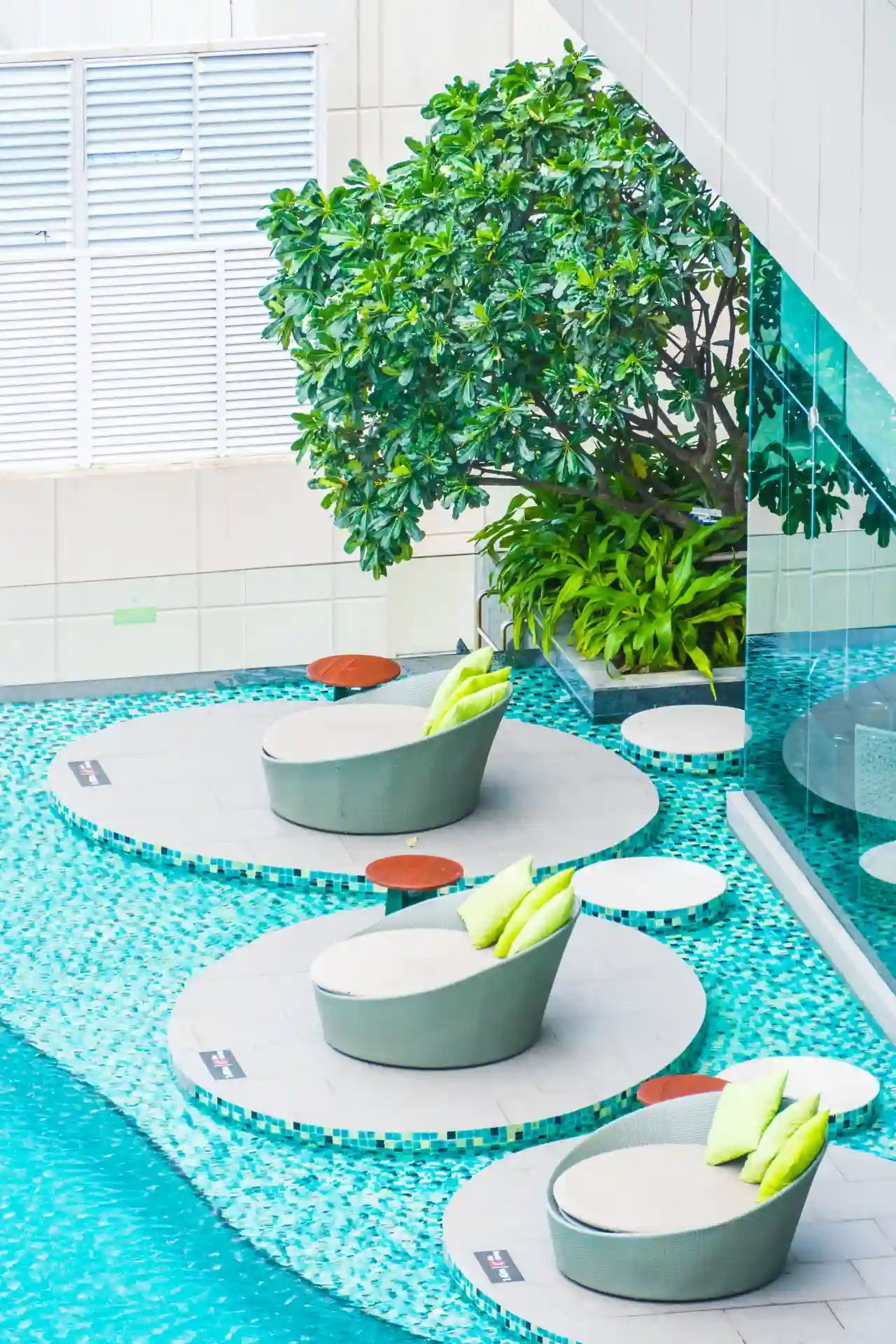
For shaded patios and screened decks, parlor palm is the low-stress choice for parlor palm pool deck setups. Gardenia notes it commonly reaches 2–6 ft indoors, which keeps sightlines open around furniture, while University of Florida references put outdoor landscape size around 4–8 ft in warm zones (it stays smaller in containers).
Give it bright, indirect light or dappled shade and a well-drained potting mix; keep soil evenly moist but never soggy. In Zones 9–11 it can summer outdoors; in cooler regions, park planters poolside for the season and wheel them indoors before cold snaps.
To reduce splash stress, position planters a step back from the coping and give foliage a gentle rinse after big pool days. (Keywords: parlor palm pool deck; small pool palms in pots.)
Mediterranean dwarf fan palm
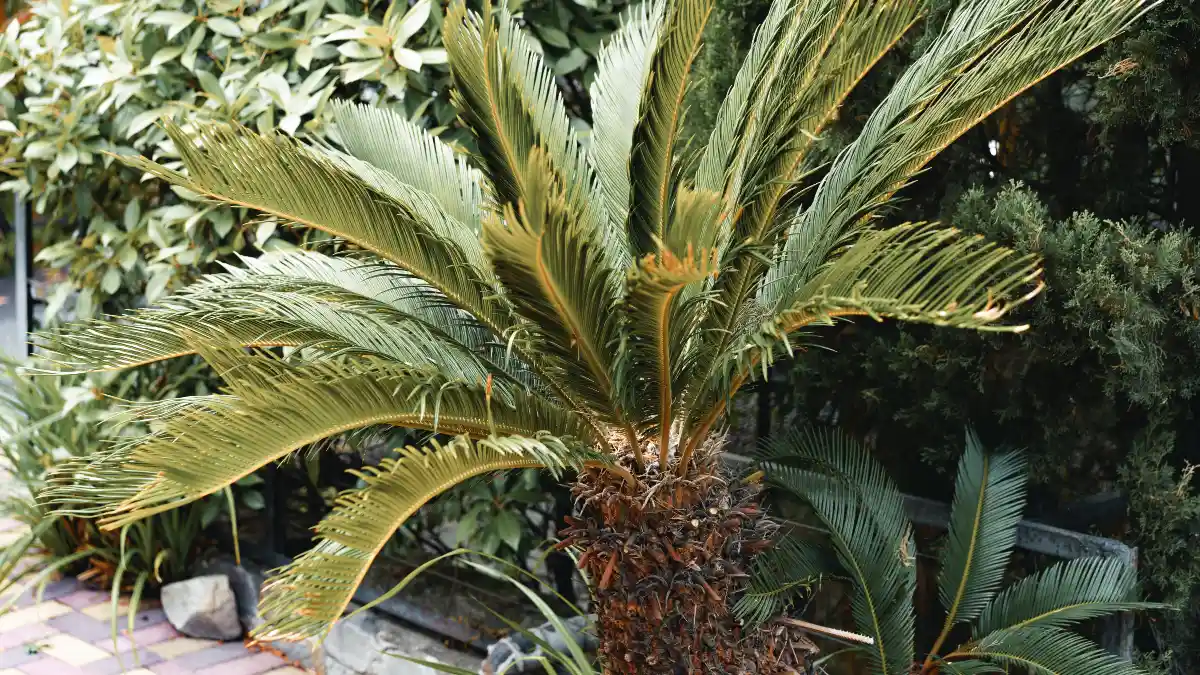
When you want a rugged, architectural clump, the Mediterranean (European) fan palm delivers. UF’s Gardening Solutions describes a slow-growing, clumping palm to 8–15 ft tall and 6–10 ft wide, with excellent drought tolerance once established.
It’s hardy for a palm (commonly grown Zones 8–11) and shrugs off heat and reflected light—great for sun-baked decks. Two cautions for pool owners: UF/IFAS horticulture sheets flag poor salt tolerance, so keep it off the coping and out of salty or chlorinated spray zones; and the spiny petioles (“teeth”) demand clearance from walkways, rails, and skimmer lids.
Use it as a set-back specimen or in a large planter where you can control distance and debris. Prune only truly dead fronds to maintain the clean, multi-stem silhouette.
Pygmy date palm
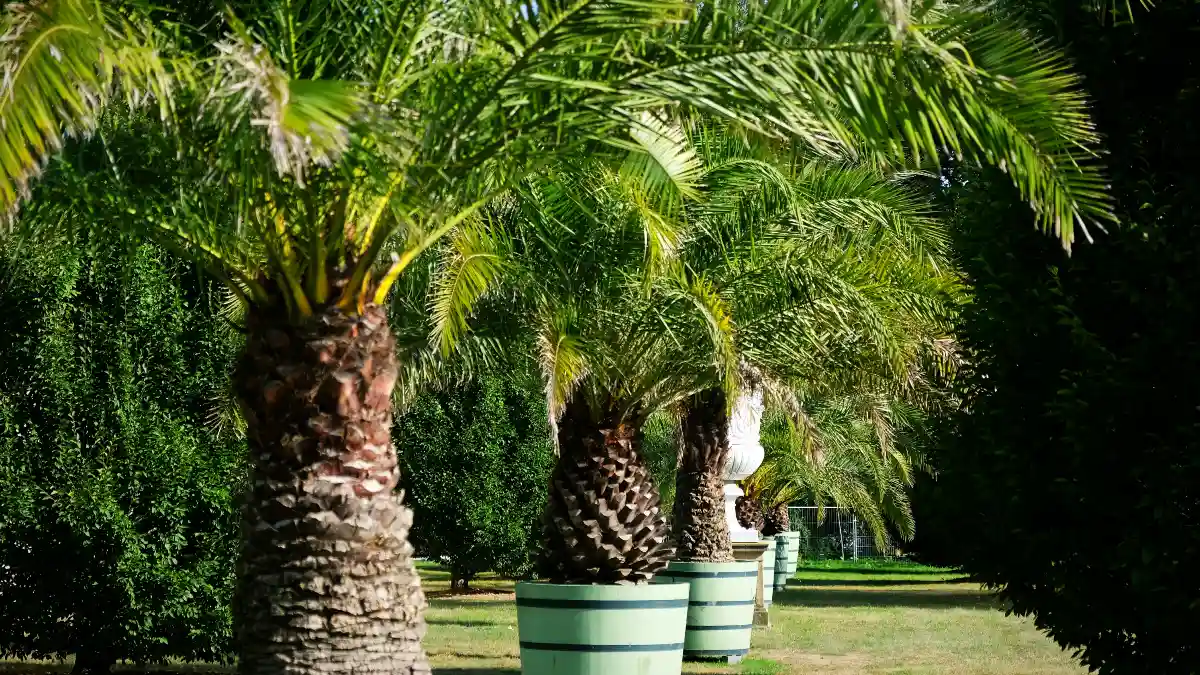
The quintessential “resort look” miniature, pygmy date palm tops out near 6–12 ft with a graceful feathered crown—perfect scale for compact courts and raised planters. UF/IFAS (Broschat et al.) documents sharp 2–3″ spines on the basal leaflets (mind kids and narrow paths), and confirms the species is dioecious—male and female on separate plants—so choosing a male avoids fruit drop around decking.
The same UF bulletin is clear on salt intolerance: this palm dislikes salt spray and saline soils, so keep it away from the coping and rinse after splash events. Growth is slow, which helps with maintenance, but feed correctly (UF recommends a controlled-release 8-2-12 + Mg landscape palm fertilizer) to prevent chronic potassium deficiency.
Place just off the waterline with a 2–3 ft mulch ring to keep grit out of skimmers.
Dwarf sugar palm
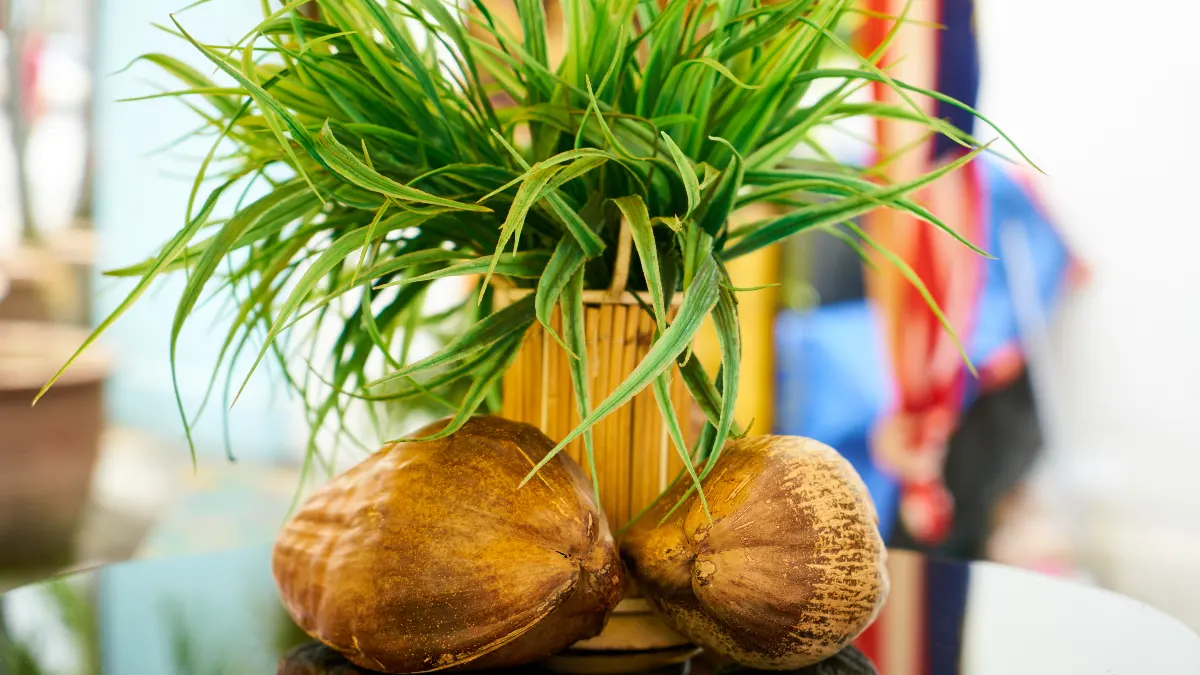
For a lush, layered look in partial shade, dwarf sugar palm is hard to beat. UF/IFAS (Nassau County) profiles a typical 6–8 ft height, Zone 9a–11 hardiness, a clumping habit, and low salt tolerance—so set it back from splash zones or keep it in a large, draining container.
It’s prized for pleasantly fragrant blooms and dark green pinnate fronds with a silvery underside that read beautifully against light stone or water. One practical caution: the fruit contains calcium oxalate crystals, which can irritate skin—wear gloves and eye protection when pruning or cleaning up fruiting clusters.
Keep soil evenly moist the first year; once established it tolerates brief dry spells but looks best with consistent water and organic mulch.
Conclusion
You don’t need mega palms to get a resort vibe. Start with climate: match USDA zone first, then filter by salt/chlorine exposure, spines/litter, and the true mature size you can live with long-term. For broad usefulness, windmill (Trachycarpus), dwarf palmetto (Sabal minor), needle palm (Rhapidophyllum hystrix), and lady palm (Rhapis) cover most temperate to warm gardens. In true tropics, the Hyophorbe duo (bottle and spindle) brings sculptural trunks without dominating a courtyard. For shade and easy planters, lean on Chamaedorea (parlor, cat, bamboo).
Next steps: measure your deck and coping clearances, check your zone, and trial one palm in a large container. If it thrives and fits the space, plant it in-ground with a sensible setback and rinse fronds after splashy pool days. This keeps maintenance low while delivering small palm trees for pool area style with the best palms for around pools.

